I researched an extensive list of things that our furry friends do and what their actions tell us to help you better understand your pooch so that you can take the best possible care of your pal.
Facial Expressions
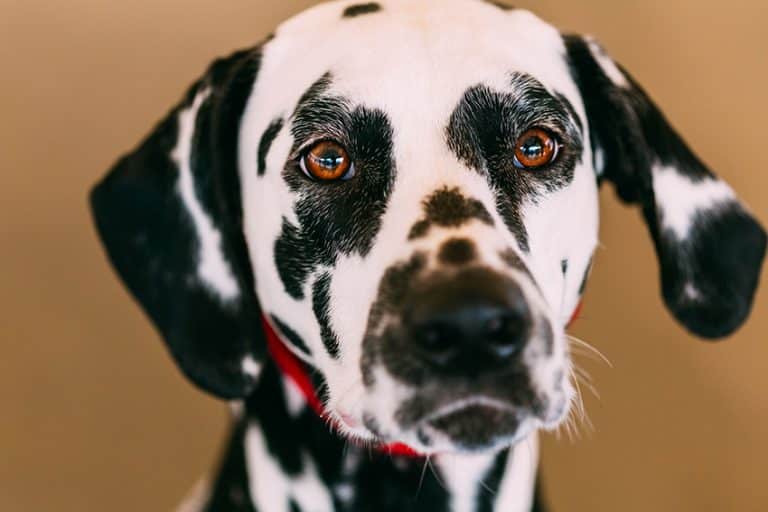
Shows 'Sad Puppy Face'
- genetic traits - dogs have two facial muscles that allow them to take on a sad countenance
- learned behavior - “the look” gets them extra attention from you
- our interpretation of Fido’s expression - we feel guilty about something and project it on our pooch
Has A "Guilty" Look
About 74% of owners think their pooches experience guilt when they’ve done something wrong. However, current research suggests that the emotion of guilt is too advanced for dogs. So why do they look or act like they know they’re in trouble?
A 2014 behavioral study by Barnard College psychologist Alexandra Horowitz shows that dogs were more likely to show guilty behaviors or expressions if they had been scolded by their owners whether or not they misbehaved. These findings suggest dogs are reacting to our cues when they display guilt behaviors.
Actually Smiling at me
When our furbabies roll back their lips and flash their teeth in a friendly greeting, are they really giving us a toothy grin? Scientists aren’t certain if the expression is a true smile or not. However, a 2017 study on canine facial actions suggests that the “relaxed open-mouth” expression is more common when dogs are in a positive setting like playtime with a furry pal.
So, when Fido greets you with a smile, he may be letting you know he’s happy you’re home. A few ways that you can keep your four-footed friend happier include planning a daily playtime together and scheduling a special outing to a local dog park.
Dog Pooping Behavior

Sniffs Around Before Pooping
Dogs seem to have a ritual before they squat to poop. They sniff around to find just the right spot, but why? It’s because this is how canines communicate with one another. They use urine, feces, and scent glands to mark where they’ve been and to leave messages for other dogs in the area.
When Fido puts his nose to the ground, he’s picking up information about all the other pups that have been there. Once he learns about other visitors, he’ll leave his own pee or poop message for other pooches. So, let your pal take his time and gather data before he goes potty.
Circles before pooping
- Your pal may be stomping down the ground cover to create a spot to poop
- It could an instinctive behavior from their wolf ancestors that lets them check for any predators or threats before taking the vulnerable squat position
- They could be marking the area with scent glands on their feet
- Dogs may also circle to line up with the earth’s magnetic fields
No matter the reason for your pup’s routine, it’s an important ritual. So, when you’re out for a walk, give your furry friend all the time he needs to do his duty.
Stares at me while pooping
You might think your furbaby looks at you while he’s pooping because he’s embarrassed, but that’s not the case at all. When Fido looks to you as he defecates, he’s showing that he trusts you. You’re his pack leader, and he’s in a vulnerable position when he’s doing his business. So, when your pal locks eyes on you, realize he’s looking to you for protection.
Kicks Up Grass After Pooping
Unlike their feline counterparts, dogs aren’t covering their feces. They’re communicating with other pups in the area in a few ways. First, canines use the scent glands on their feet to leave a strong pheromone message. But kicking up clods of grass also leaves visible scratch marks for other pooches to see.
So, what can you do to keep your four-footed friend from tearing up your yard? Try taking out a special treat or toy. When your pooch finishes his business, call him over, and offer the reward to distract him. He may just forget to scratch. Another option is to train your pal to go potty in a designated area so only one part of the yard is affected.
House Soiling (Marking)
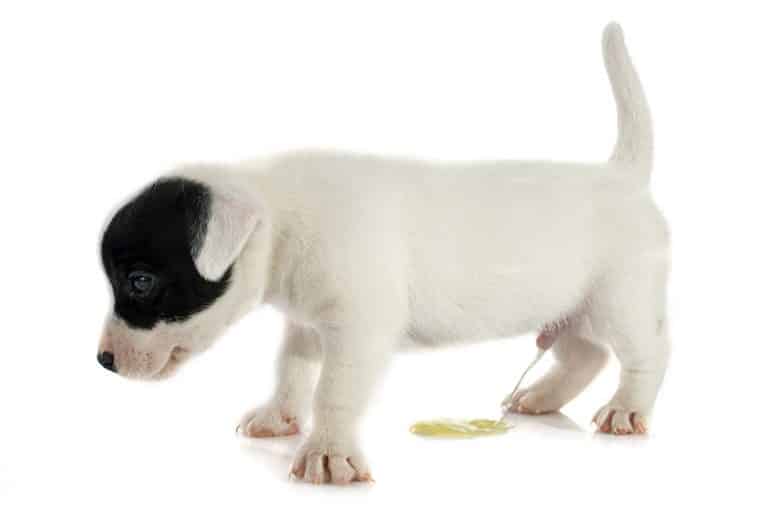
Peeing & Pooping on the Bed
- They’re feeling anxious or stressed about something.
- Fido may have lost bowel or bladder control in reaction to something that unexpectedly scared him.
- There could be an underlying medical condition.
Pooping In The House
- He’s feeling stressed over a change in routine or other circumstances
- He’s getting older and is either forgetting to go outside or is losing bowel control
- He has a medical condition that’s causing diarrhea
So, if your special pal starts leaving calling cards around the house, it’s time to call the vet. Take him in for a check-up to rule out things like parasites, a food allergy, an infection, or cancer.
Poops In The House In Front Of Me After Being Outside
Is it revenge? Not at all. It’s natural and instinctive for them. Dogs often use their poop or pee to communicate with other animals and to mark territory. So, even after investing time and effort to housebreak your furry pal, he might not understand that he shouldn’t leave a message inside. He may think he’s bringing you a gift. Lovely!
If there’s no medical reason for your pal’s behavior, he may be trying to tell you that he’s stressed or afraid. Your pal might feel unsafe going outside because something in the yard scares him. Rather than getting in a vulnerable position out there, he wants to come in for your protection.
Another reason for doing his duty inside could be that he was too busy playing and forgot to do his business. Or maybe your schedules are out of sync and he’s not ready to go when you let him out.
Whatever the reason for pooping in front of you, don’t punish your pal. Schedule a check-up with your veterinarian to make sure Fido isn’t sick. You may want to limit his access to uncarpeted parts of the home. Another option is to use potty pads or dog diapers for poop.
Eating Poop (Coprophagy) - Their Own or Other Animals
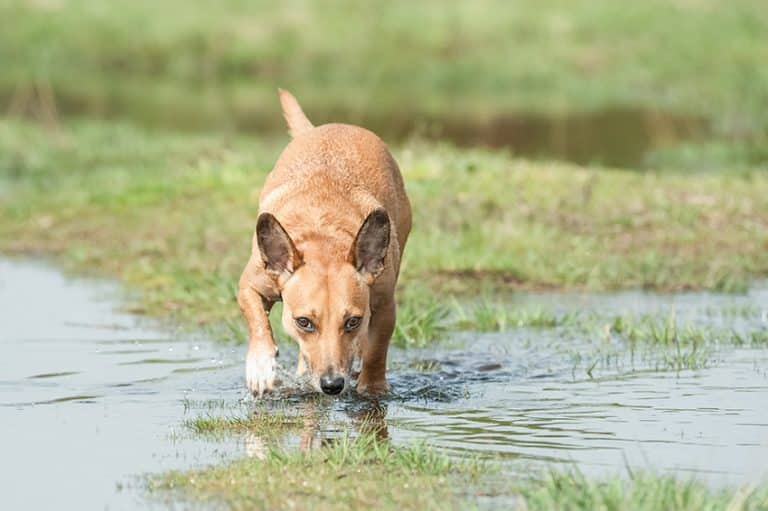
How to Stop Your Dog From Eating Poop
- It’s instinctive. Bitches will clean their puppies, poop and all either to keep the den clean or protect their young from predators
- Puppies often eat poop, and some never grow out of it.
- Some dogs like the taste. Eww!
- Dementia, a nutritional imbalance, parasites, and other conditions can trigger coprophagy
- It may be to hide evidence of their presence from predators
- As an act of submission to dominant pack members
- They’re bored or trying to get your attention
- To hide the evidence from you if they went in a forbidden zone
Eating Cat Poop
If your pooch is raiding the cat box, schedule a checkup with your vet to rule out a medical condition. Then, find a way to restrict your pup’s access to the litter box. Try using self-cleaning or covered potties for your feline. You can also set it in a room behind a baby gate as long as Fido isn’t a jumper.
Eating Rabbit Poop
- He’s hungry and will eat anything that resembles food
- He likes the flavor
- He sees the poop and tastes it out of curiosity
- He has a nutritional deficiency
- There’s an underlying condition causing the pica (indiscriminate eating)
The good news is that rabbit poop isn’t likely to make your dog sick. If you want to prevent your furbaby from munching on these pellets, closely observe him when he’s in the yard. It’s also helpful to teach your pal the “leave it” command so that you can deter him even when you’re not standing right beside him.
Dogs and Dirt
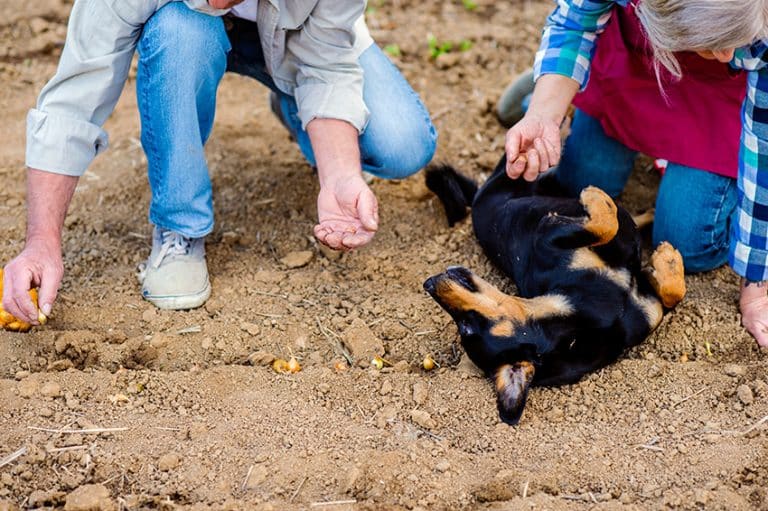
Rolling in dirt & Mud
- Hold-over hunting instincts prompt him to roll in dirt or mud to cover his scent
- He’s leaving scent from his legs and back to mark his territory
- He likes the smell
- He’s collecting information to bring back to his pack
- He’s trying to erase the shampoo scent and restore his unique smell after a bath
kicking up dirt
When Fido starts throwing dirt with his hind feet, don’t scold him. He’s just trying to communicate with other pups.
Let's Talk Dog Humping

Help! My dog humps
- If you think Fido is doing this because he’s not getting enough other stimulation, try providing additional walks, playtime, or a puzzle toy.
- For some pups, the behavior is anxiety-driven. If your pal resorts to humping in awkward social situations, find ways to increase his level of security. Teach them alternative behaviors like chewing on rawhide or playing with a treat-dispensing toy.
- If your furbaby only mounts occasionally, he may just enjoy the sensation. As long as it’s not at inappropriate times, you can just let him be.
With a little time and attention, you should be able to figure out what triggers your furbaby and find ways to redirect the behavior if needed.
Humping my leg and other people
- It can be an act of dominance
- It’s a play gesture
- It’s an expression of excitement
Humping other dogs
Humping other things and the air
- There could be an underlying condition like a urinary tract infection or an awkward itch
- Dogs may be exerting dominance and claiming the object or space as their territory
- It feels good - yes, your pooch may find humping a toy pleasurable
- They’re expressing excitement or anxiety
- They could be trying to get another dog to play
If your pup suddenly starts mounting objects or humping the air, talk with your veterinarian about the new behavior. It may be time for a checkup to rule out diseases. If Fido has a clean bill of health, the bottom line is that this activity is normal and natural for your pal. Unless it becomes compulsive, let your pal have his moment.
Dog Rolling Behavior
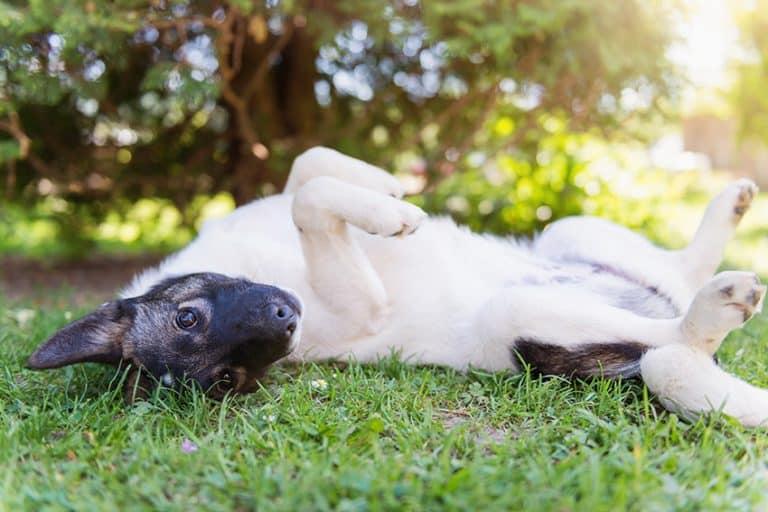
Rolling around
- To rub off a scent like perfumed shampoo
- To scratch an itch in a hard to reach area like the back
- Your pal is showing he feels secure and relaxed with you
- Exposing the belly helps them cool down
- Your furbaby is seeking love and attention
if your four-footed friend wants to get down for a roll while, let him. He’s showing you how secure and happy he is with you.
Rolling in the grass
- The activity may help scrub or dislodge debris, dry skin, or tree sap
- He may be marking territory or adding a new scent to his coat
- He may take pleasure in the activity and find it relaxing
- Exposing the belly helps them cool down
- Your furbaby is seeking love and attention
As I outlined above, rolling behavior is normal and usually not a cause for any concern. However, if the activity is continual, goes on and on, or seems unusually intense, contact your veterinarian. It could be that Fido has a dermatologic or other condition that’s causing irritation.
Rolling On His Toys
Rolling behavior isn’t just for outside. Some pups will roll on their toys or other objects indoors. They may be marking the item with their scent to claim it. Some things also make good back-scratchers or provide a comforting massage. As long as your furbaby doesn’t do this non-stop or compulsively, just rack it up to natural behavior.
Rolling in Stinky Stuff
- Some say that it’s a carry-over from wolf ancestors. They smear the gunk all over their fur to bring a message back to their pack. It tells them where they’ve been and what they found.
- Others say it’s due to predatory instinct. They use rancid stuff to mask their odor from prey.
- Another theory is that dogs are leaving their scent on the smelly item. They just happen to pick up the stink when they roll.
- It could also be that dogs like the aroma of the obnoxious smelling thing.
- If his favorite thing is his feces, clean up as soon as your pal goes potty.
- Use a short leash when walking your pooch and watch him closely. That way you can pull him away from dead animals, poop, or other icky stuff.
- Link the rolling action to an unpleasant experience, like: A loud, annoying sound, A squirt from a spray bottle, A remote collar that sprays citronella or another scent that dogs hate
Hopefully, with patience, perseverance, and some yummy treats, you’ll be able to train Fido to stop rolling in stinky stuff. If not, you may be able to reduce the frequency.
Dog Licking Behavior

Licking and Grooming Other Dogs
- Puppies may lick their mama’s face asking to be fed
- For some adult canines, it’s an act of respect or deference
- Other pups lick as an act of affection or playfulness
- Sometimes, licking is a way to say “hello”
- Dogs will also lick each other’s fur or eyes to assist them with grooming
In addition to these, pooches lick to help them bond and relax. Dog trainer Victoria Stilwell tells us that licking releases hormones called endorphins in both the licker and the recipient. These substances stimulate feelings of comfort and pleasure for the pups and contribute to bonding. In the wild, pack members lick each other to build a close-knit group. Even though their survival doesn’t depend on pack cohesiveness, our domesticated furbabies still have this instinct. So if you have two dogs that like to groom each other, they’re helping one another relax.
Licking himself excessively
- A yeast infection between the toes or around the genitals
- It’s a compulsive habit and may indicate stress or anxiety
- There could be a painful or inflamed area
- Your pal might have a foreign body between the toes or in his mouth
- If he’s licking his feet, he might have a cracked nail or a growth between his toes
- He could have allergies
- There might be an underlying medical condition like dementia or a seizure
Licking his lips
The bottom line is if you see your special pal licking his lips or the air, he may be telling you that something is stressing him out. Try to provide a calming environment and reassure your furbaby.
Licking his wounds
- Enzymes like lactoferrin that destroy bacterial cell walls
- Other antiviral and antibacterial compounds
- Growth factors and protease inhibitors that support wound healing
- The natural pain reliever Opiorphin
- Nitrate compounds that break down to nitric oxide when saliva contacts the skin. This process inhibits bacterial growth and promotes healing.
Licking things obsessively
- Lack of nutrients
- Cushing’s Disease or hypoadrenocorticism
- Liver failure
- A neurological disorder
If your furbaby starts licking things all the time, contact your veterinarian for a checkup. They can help you get to the root of the behavior.
Licking His Nose
Dogs lick their noses a lot, but why? One reason they do this is that it helps them smell better. The tongue collects scent particles and transfers them to a specialized scent organ (Jacobson’s Organ) in the roof of their mouth.
- To clean it off
- To show confusion or anxiety
- Medical reasons like a bee sting, foreign body, trauma, or an infection
- They’re feeling nauseous
- To wipe off a nasal discharge
- It can be a sign of a seizure
If your four-footed friend seems to be licking his nose excessively, check the muzzle for signs of injury, foreign body, or other problems. You should also set up a veterinary exam to help you find out what’s causing the behavior.
Licking Blankets and pillows
If your canine companion keeps licking your bedding, try leaving an old clothing item of yours on the bed to comfort him when you’re not around.
Licking my underwear
- The elastic reminds them of a toy
- Face it, dogs love stinky stuff
- It carries your scent and reminds them of you
- The color may be attractive to them
- It gets your attention
Not only is this behavior annoying, but it can also be unsafe for your pooch. If your pal eats a pair of boxers or socks, it could cause an obstruction. To help prevent problems, make sure your pooch can’t get to your underwear. You can also use bitter apple spray to make the garments less desirable or offer a variety of toys that keep your pup’s interest.
Licking his bed
If your pal settles into bed and licks for a spell, he may just be doing something to help him go to sleep. On the other hand, excessive licking may be a sign of a problem or condition. Check your dog to see if he’s focusing on a particular area or if there are signs of parasites. If he’s focusing his attention around potty areas, you may want to take him to your vet. There could be infected anal glands or another issue that needs treatment.
Licking human body parts
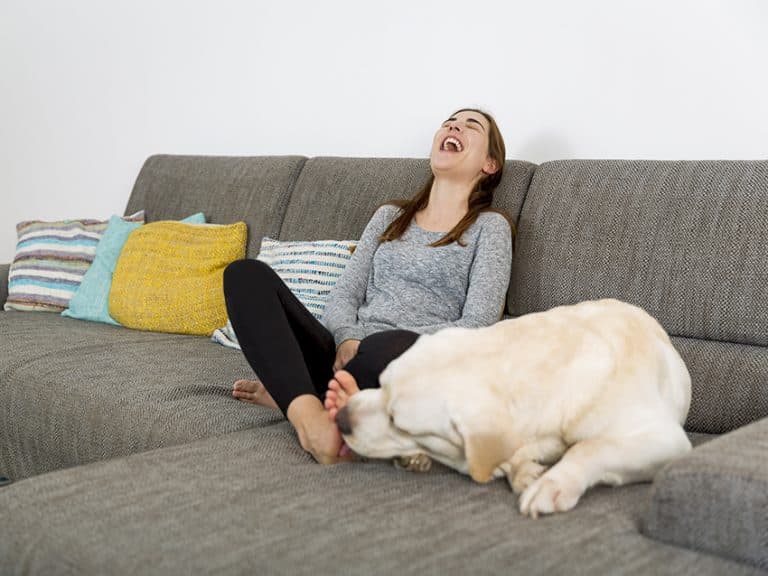
Licking my wounds
Licking my face
- They love you and are showing their affection
- They want something from you like dinner or a walk
- They’re showing you their respect
Grooming me
- Your tears and sweat have salt that tastes good to him
- Natural moisturizers and lotions may smell and taste good to your pooch
- Licking gets your attention
- It’s a natural way for him to show his affection for you
- Social grooming behavior stimulates a release of oxytocin and other positive hormones
- Intense or excessive licking may mean he’s anxious or stressed about something
- Licking can be a sign of deference or submission
- Dogs may also lick because they detect a health problem like low blood sugar
Unless your pup goes overboard or his licking gives you the creepy crawlies, it usually won’t pose a health risk. But, if you want to discourage the behavior, Victoria Stillwell from Animal Planet recommends you ignore your dog and walk away when he starts to lick you. With repetition, your furbaby will learn that licking brings no reward.
Licking me when i pet him
Dogs are mutual groomers. They often use licking:
- to communicate affection and other messages
- As a sign of conflict behavior
- To exhibit stress
When you reach out to pet your furbaby and he starts licking you, check his body language. He may simply wants to return the favor, or he could be telling you that he’s feeling stressed or threatened. The behavior may also help comfort your pal because the action triggers a release of endorphins.
If your pooch turns to lick you when you pet him, take it as a compliment.
Digging behavior
Loves digging
- It’s a predatory instinct carry-over from wolf ancestors
- They’re uncovering cool earth on a hot day so that they can lie in it to cool off
- To bury treasure like a bone or favorite toy
The bottom line here is that the behavior is natural for your pal, so you shouldn’t punish them. Instead, you can try to redirect Fido’s behavior. Provide a designated digging area or a doggie sandbox. For some pups, digging is a signal that they have extra energy. Take extra-long walks or play ball with your furbaby to burn off some vigor.
Digging in his bed
- Some are making a nest
- It helps regulate their body temperature by making their resting place warmer or cooler
- They may be creating a den where they can hide
- They’re “fluffing” their pillows to be more comfortable
- The digging action marks the bed as their territory
If your pooch messes up your comforter or the throw on the sofa, he’s not misbehaving. He’s just preparing his bed.
Digging at Carpet
- They’re trying to dislodge tasty crumbs that they can smell
- Like their bed, they’re trying to “fluff” the area before laying down
- He’s anxious or excited about something
If your pal scratches at the carpet on rare occasions, it’s probably not a big deal. But if the frequency could threaten the rug’s lifespan, here are some measures you can take to redirect the behavior: As soon as the pawing begins, get your special pal’s attention and call him to you. Then you can run him through some obedience drills and provide treats to divert his attention. Another way to redirect your furbaby’s energy is to take him for a walk or get him a puzzle toy. If your pup seems to be digging for crumbs, consider vacuuming more often.
Sniffing Everything
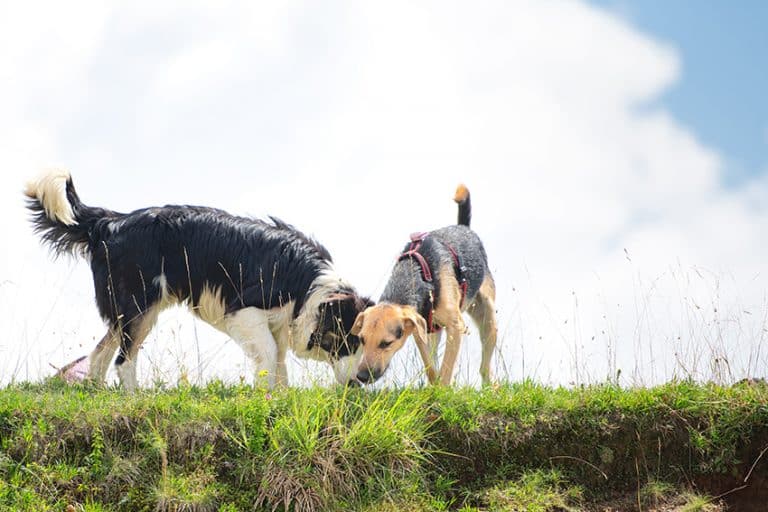
Loves sniffing
Loves Sniffing People
- Your mood
- Hormonal changes such as occur with pregnancy
- Whether you’ve been with friends or strangers
- Some illnesses, including diabetes and cancer
We may not know what smells our pups are picking up when they greet people on a walk. But they have a way of letting us know what they like.
Sniffing My Crotch (awkward!!!)
Even though it’s a natural behavior, it can be embarrassing when your furbaby sticks his nose in a visitor’s crotch. To prevent the behavior, have your guests offer a hand or fist to sniff as soon as they meet Fido. Your pal will be able to get the same information by sniffing these body parts. Another thing you can do is put your pup in a sit-stay when a new person comes into the house.
Sniffing My Breath
The bottom line here is that if you’re comfortable with your pooch getting up close and personal, it may strengthen your bond. However, if you’d rather have more space, find another way to connect with your pal like going for a walk or playing a game of tug.
Sniffing Other Dog’s Butts
Is it ok to let my dog sniff other dogs? As long as you’re supervising the encounter and both parties are healthy and well-socialized, it helps them get to know one another. Keep an eye on them and watch the body language. If one pup gets too intense and the other one starts acting stressed or annoyed, pull them apart. You should also introduce unfamiliar canines in pairs to minimize the risk of overstimulation and fighting.
Dog Sitting Behavior
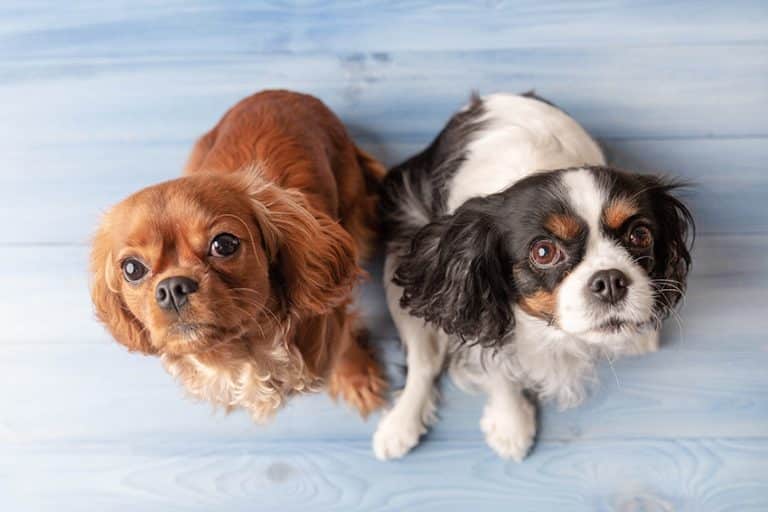
Sitting in my spot when I get up
- Preference - When you sat down, you took Fido’s favorite spot, so he’s taking it back in your absence
- Attention/rewards - you’ve actually trained your furbaby that he gets extra attention or rewards when you come back and ask him to move over
- The spot has your scent - If you come home to find your pup in your normal spot, he may be showing that he misses you when you’re gone
What can be done? First, don’t drag your pooch off the seat. Train him to find another resting place. Call your pal off the couch and put him in a “sit-stay” or “down-stay.” Once he complies, provide a tasty treat. Then ignore your pup and go back to reading, watching TV, or whatever you were doing before. It won’t take long for your furbaby to figure out he needs to find his own spot.
Loves Sitting On Me
- For warmth - if you’ve seen a puppy pile, you know that dogs tend to huddle up when they’re cold
- To show affection - he wants to be near you and get extra bonding time
- For reassurance - something is making him nervous or anxious
- To claim you - he’s marking you as his personal territory
- To protect you - he’s guarding you
- He wants something - either he’s bored and wants more activity, or he’s seeking attention
If your furbaby doesn’t sit on your lap, should you be worried? Not at all. Just like their masters, dogs have different personalities. If your pooch isn’t the snuggly type, he might follow you around the house to show his affection. Enjoy his unique ways of communicating with you.
Sitting On My Head
Head sitting tends to be more common with small breeds and younger pooches. Puppies usually engage in the behavior when they’re part of a pack to be close to their littermates, but some continue into adulthood. Your reaction can also encourage the activity to continue. If you yell and chase Fido, he might think it’s a game and continue to plop his butt on your noggin to start the play session.
What can be done to teach your pal to find a different seat? You need to break the cycle by stopping whatever reinforces the behavior. Pay attention to how you react to Fido when he sits on your head and change what you’re doing to encourage him to find a better spot, like your lap. You may need to consult with a trainer about command signals that tell your furbaby to get down. If you think that your pooch is plopping down on your head for warmth, set up a comfortable dog bed or blanket in a warm spot in your home.
Sitting Behind Me On the Couch
- It’s a comfortable spot for them
- It’s a great vantage point to guard you and the house
- They can be close to you without risk of being crushed
The bottom line is that sharing the couch with your furbaby can be rewarding for both of you. But if Fido starts guarding the spot and getting aggressive, you need to take steps to redirect the behavior.
Sitting Next to Me When I'm On the Toilet
- It’s a pack thing - they want to be near you
- Curiosity - they want to know what you’re up to
- Protection - they’re trying to keep you safe
- Companionship - they don’t want to be left alone
If your pooch doesn’t have anxiety issues, there’s nothing wrong with diverting him to another room when you need to use the bathroom. Of course, you could just let him follow you in there. It’s only fair since you see him go potty all the time.
Sitting On Cats
- Passive aggression - they’re getting revenge for the hissing and swats
- Butt hug - they’re trying to show affection but don’t want a scratched nose
- Acceptance - they’re telling the cat they belong to the same pack
Face it, animals can be weird. The bottom line here is, as long as your pets seem to be getting along, let them work it out. Remember to keep an eye on the interactions just in case what appears to be playful fun turns into aggression.
Sitting On Other Dogs
- He’s snuggling up to get warm
- He’s affirming his relationship as a pack member
- Some dogs use the behavior to initiate playtime
- The more senior dog may sit on his younger companion to calm him down
The bottom line here is that if the dog on bottom resents being a chair, you could have a problem. Monitor your pups closely for any signs of aggression and take immediate action to diffuse the situation. Talk to a trainer to learn command cues that remind both furbabies to stay calm.
Dog following behavior
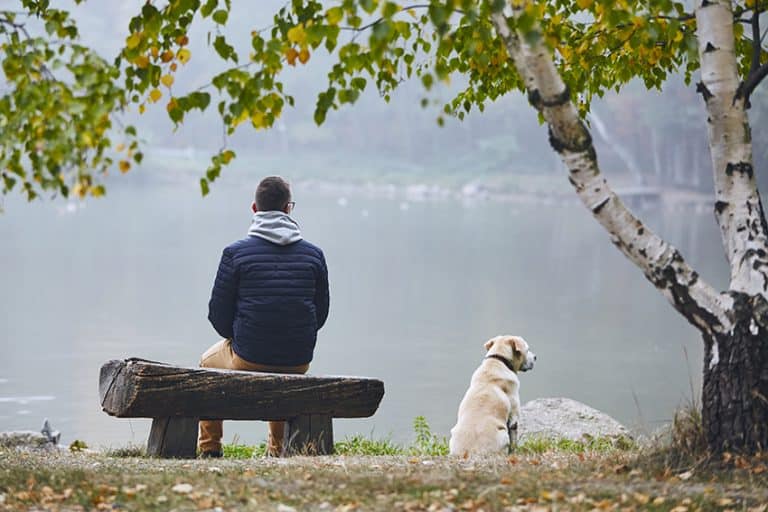
Following Me Everywhere
- He’s reinforcing your bond by sticking close
- For some breeds, it’s an instinctive trait
- He wants companionship
- He suffers from separation anxiety and wants to make sure you’re not going anywhere
Following Me But Not My Partner Around
- Your pooch views you as the pack leader
- He may have bonded to you and not your partner or spouse
- If you had Fido before, your pooch may view your partner as an interloper
- Your pup may pick up on negative vibes if your partner gets angry or acts hostile toward you
- Your partner may have a scent that your dog doesn’t like
The bottom line is that if your pooch is at odds with your partner, there are things you can do to improve their relationship and keep peace in the house.
Dog Nesting Behavior
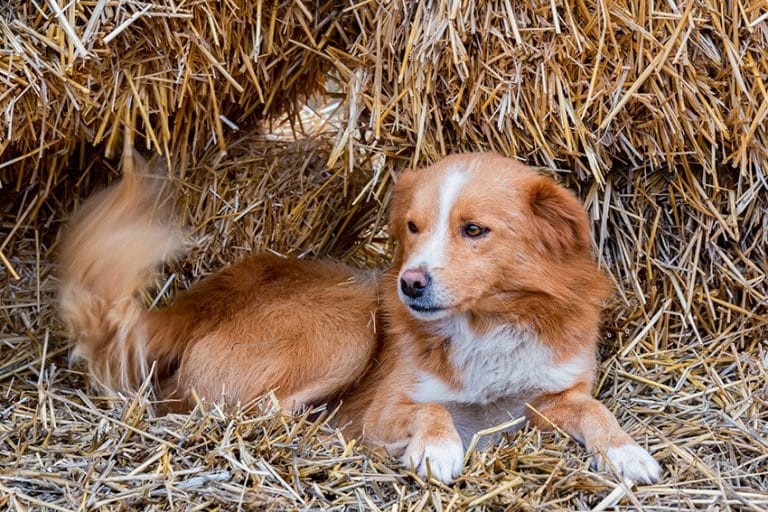
My dog is nesting
The bottom line is that nesting behavior is normal and healthy for your pooch. If your pal builds a den or private area, treat it with respect to foster his sense of security.
Circles Before Lying Down
The bottom line is that circling is a natural behavior. In most cases, it’s not a reason for concern. However, if your special pal starts circling and pawing at his bed but never seems to settle into a comfortable spot, it could be signs of a health problem. Watch your furbaby to see if he’s having difficulty getting up and down or moving around. If the restlessness persists, contact your veterinarian to get to the root of the behavior.
Going Around In Circles
- They’re bored or anxious and trying to work off excess energy
- A newly rescued dog with obsessive-compulsive tendencies may be adjusting to the new home
- Your pooch may have an inner-ear infection that’s affecting his vestibular system
- Some parasitic infections can trigger circling behavior
- Neurological conditions including head trauma and dementia can cause circling
The key here is that turning in circles usually points to an underlying condition. With the appropriate diagnosis, you’ll know the best steps to take for your pal.
Crying and Whining

My dog is crying...why?
- Let you know they want something like dinner or a walk
- Tell you they’re nervous or anxious about something
- Tell you they’re frustrated or something is hurting them
- Let you know that they’re bored and want your attention
If your furbaby is whimpering or whining, he’s trying to communicate a need. Take some time to observe your pup and see what he’s trying to say. If he needs something like food or water, attend to his needs. Offer comfort if he’s anxious. If you think he’s in pain, call your vet. By listening to your pal, you can help him stay healthy and happy.
Crying at night
- A new puppy may not be used to living without his littermates and mama
- If you’re crating your pal, he may be telling you he doesn’t want to be separated
- A senior dog may be feeling aches and pains
- A pooch with dementia could be afraid of the dark
- He may be telling you he has to go potty and don’t want to soil their kennel
The important thing to remember when addressing the behavior is that it’s counterproductive to scold or punish your furbaby for crying at night. You’re more likely to increase any anxieties or fear by yelling at your pup. Instead, take time to understand the reasons your pal is whining and address the issue.
Crying When I leave
There are many ways to help your special pal learn to cope when you can’t be there. With a little time and attention, you can find the best solution for your furbaby’s needs.
Appears to cry real tears
- An irritant like a dust speck got in the eye and may have scratched the cornea
- They have an allergy
- They have an eye infection
- They have a blocked tear duct
Even though your furbaby can shed tears, it’s often a sign of a problem. Sometimes it’s as simple as a speck of dirt or an eyelash. In that case, the droplets will wash the irritant out. However, if the crying persists, there could be something more serious going on. Watch your furbaby to see if the tears continue and take him to the vet if needed.
Destructive Chewing Behavior

My Dog is Chews Everything
- The behavior provides an outlet for separation anxiety
- They like the taste or smell of some objects
- They have too much energy and are bored
- You reinforced the behavior by giving them treats to stop chewing
The bottom line here is to teach your furbaby to avoid objects that you value. Finding something else for your pooch to enjoy can help redirect his unwanted behavior.
Chewing On Me
The key here is that your canine companion needs to learn appropriate behavior around people for everyone’s safety.
Chewing On His Paws
- They have an infection caused by an injury or parasites
- They’re suffering from an allergy or atopic dermatitis
- They’re bored or anxious
- They need a nail trim
Chewing On Blankets
Chewing On Wood/Rocks or Sticks
- They may like the flavor of wooden objects
- Sticks can resemble some bones and chew toys
- Dogs chomp on things when they’re bored or frustrated
- Sometimes pooches gnaw on anything they can find to ease teething pain
- They’re trying to get your attention
- They’re dealing with separation anxiety or fear
- They have a medical condition like dementia, thyroid problems, or intestinal parasites
- They may be suffering from malnourishment or a nutritional deficiency
The bottom line here is that eating things like rocks and woods can be dangerous for your pooch. Do what you can to discover what’s causing the pica and to redirect your pup’s activity.
Chewing on my personal items
- They’re bored or lonely
- They’re experiencing separation anxiety
- They like the scent or taste of the item
- They’re trying to get your attention
- They have dental issues that need attention
The bottom line is that you should expect some aberrant chewing with new puppies. But as Fido matures, he needs to learn proper gnawing etiquette. With time and patience, you can train your pal to stop chewing on forbidden items.
Dog Eating Habits
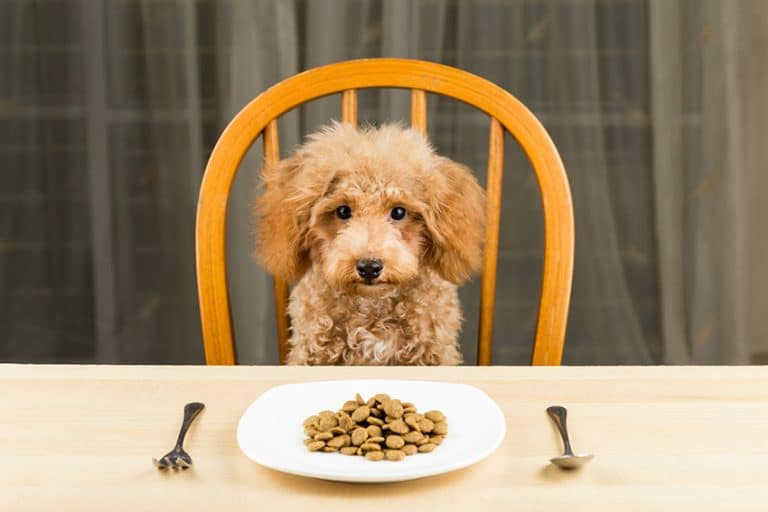
My Dog eats everything
When your pal snarfs up a stale piece of popcorn that skittered under the chair, it’s not that he has a warped sense of taste…It’s because he was born that way.
Eating too fast
- They have a self-preservation instinct and eat fast to make sure no one takes their food
- They’re competing with other pets in the house
- Abandoned pups or rescue dogs may eat fast because they’re not sure if they’ll get another meal
- Medical conditions like diabetes or Cushing’s disease can make your pal ravenous
When your pal gulps his dinner, he’s at risk for choking on the boluses of food. This action can also lead to upset stomach and vomiting because the gut receives a large volume of material so quickly. But the most severe effect of eating too fast is that it can lead to bloat or a twisted stomach.
There are some things you can do to discourage food gulping. If you’re a multi-dog house, feed your pups further apart or in separate rooms. That way Fido won’t feel the need to compete or try to finish before his canine companion. In the case of a single furbaby, you can invest in a slow feed dog bowl to help your pup take more time when he’s eating.
The important point here is that gulping food can be dangerous for dogs, but there are some simple things you can do to prevent the behavior.
Eating his Throw Up
- It smells like dinner and may contain undigested bits of food
- Their wolf ancestors and some female dogs today will regurgitate food to feed young pups
- They want to hide the evidence so other animals don’t know they’re sick
Face it. It’s disgusting to think about a dog eating his own vomit, but it’s normal behavior. And on the plus side – if Fido licks up his own mess you won’t have to!
Has stopped eating
- Medical issues ranging from a mild upset stomach to a twisted stomach or intestinal blockage
- Eating something poisonous
- An infection
- Allergies or a reaction to a vaccination
- Dental problems like a cracked tooth or sore gums
- Pain from an injury or arthritis
- Depression
- Tumors
The key here is to get your pup eating again ASAP. Work with your veterinarian to treat underlying causes and find ways to get Fido back on his food.
Eating dirt & mud
- Exercise him regularly or teach him new commands to occupy his time and energy
- Distract him with alternatives - chew toys or an activity like playing fetch or running
- Cover the ground in the areas where Fido tends to eat dirt
With a little effort, you should be able to redirect your pal’s behavior and stop the dirt-eating.
Likes Eating Snow
- Your dog thinks it’s fun to eat and play with
- They’re thirsty and the snow is more convenient than going inside
- Nauseous dogs may gulp snow to induce vomiting
The bottom line here is to avoid letting your pup eat snow or drink from puddles that might be contaminated with ice melt. If your furbaby is in the yard and gulps untreated snow because he’s thirsty, bring him inside. Give him a bowl of water to prevent vomiting.
Shredding Paper
- Your furbaby may have pica or a condition of eating non-food items
- He may be chewing on paper to relieve pain in his mouth from teething or a dental problem
- He’s bored and blowing off some energy
- He’s just trying to have some fun
- He’s hungry either because you’re underfeeding him or he has a medical condition
The point here is that dogs have an attraction for shredding paper, but there are things you can do to prevent the behavior.
Eating socks
The bottom line is that dogs have an attraction to socks, but you can avoid expensive and painful consequences by taking preventative measures.
Eating Tampons (Yuck!)
- Contact your veterinarian
- Watch for signs of obstruction like inappetence, lethargy, vomiting, constipation, and a painful abdomen
- Store your sanitary items out of Fido’s reach to prevent a recurrence
- Redirect the behavior by providing him with interesting toys
As always, prevention is the best cure. Take steps to keep tampons out of reach from your pooch.
Eating Plants

Eating Bugs
The bottom line is that while many bugs are like potato chips for pups, it’s still best to avoid insect-rich areas. That way you can decrease the risk that your furbaby will get sick from too much snacking.
Eating Grass and Throwing Up
Urine-marking behavior
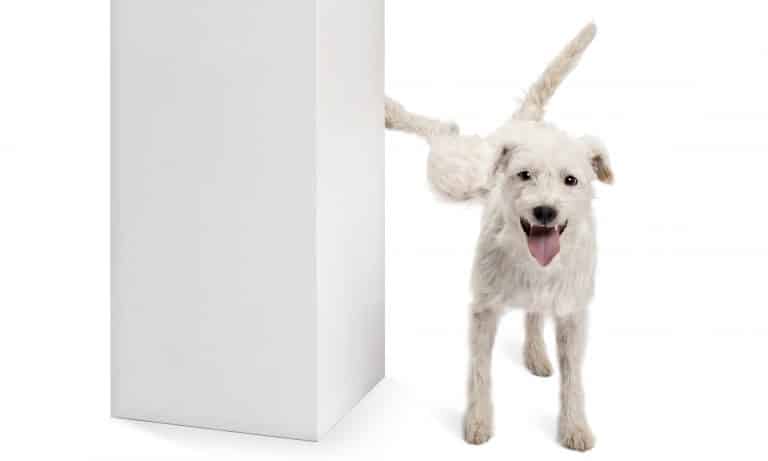
Peeing in the house
- Something changed like a new pet or a baby joined the family or an older child left for college
- You remodeled and changed his routine or environment
- The family schedule changed and it upsets Fido’s routines
- Your furbaby is anxious, fearful, or excited
- Hormone imbalances or side effects of a medicine are causing incontinence
- Your aging dog has an issue like kidney disease or dementia
- There’s an underlying medical condition like diabetes or a bladder infection
- When did this changed behavior start?
- How often does Fido pee inside?
- What time of day is this happening?
- Is the behavior in a specific place or all over the house?
Peeing on the bed
- They could have hormone-responsive urinary incontinence
- He has diabetes, a urinary tract infection, or another disease
- He’s marking your bed as his territory
- You’re no letting him out to go potty enough
- He’s stressing over a change in the routine or his surroundings
- Something is triggering a fear response
- He has arthritis pain and doesn’t want to get up or move
Peeing In Front Of Me In The House
- Your furbaby isn’t fully house trained
- He’s showing excitement, intimidation, or submission through submissive urination
- He’s marking territory possibly in response to a new pet or other changes in the house
- He’s telling you that something is causing him to feel anxious or fearful
No matter the reason for the peeing, there are some things you can do to correct the behavior. Try to identify the trigger that’s causing the urination so that you can eliminate it or retrain your pup to deal appropriately with it. Remember that yelling at or scolding your furbaby may increase his stress and lead to more submissive peeing. If you must, go back to square one with potty-training. Increase your pal’s potty breaks if you think there are any incontinence issues.
In addition, make sure you thoroughly clean up any messes. Use an enzymatic cleaner to eliminate urine odor.
With some TLC and diligence, you can retrain your four-footed friend to pee outside rather than at your feet.
Peeing On me
- Your dog may be showing submissive urination and hit your leg or foot
- There could be a urinary incontinence issue
- He’s marking you as his territory if there are other dogs nearby
- He’s resource guarding by laying claim to you
- He may be communicating anxiety or fear about something
The bottom line is that no matter the cause, there are steps you can take to redirect your pooch’s activity and stay dry.
Peeing On Me When I Pet Him
- Puppies have an immature bladder sphincter and tend to pee when they get excited
- For adults, it’s often an act of submissive urination
- He may be anxious or scared
The take-home message is to be purposeful and plan ahead. Build your pal’s confidence in his ability to please you.
Peeing On Fire Hydrants and Tires
When your pal waters the fire hydrant or your neighbor’s tires don’t scold him. He’s simply leaving a message for other pups in the area.
Peeing On His Leash and Other Dogs
Loving your pooch doesn’t mean you have to put up with inappropriate behaviors. Train your furbaby to understand proper urination etiquette. You can take your furbaby for a morning walk to encourage him to drain his bladder outside rather than on a packmate. The exercise will also help burn off excess energy.
Peeing In His Sleep
There may be times when your furbaby won’t be able to control his bladder as he sleeps. This urinary incontinence can be due to:
- Bladder infection
- Kidney or urinary tract stones
- A spinal injury or intervertebral disc disease
- An enlarged prostate
- Some diseases like Cushing’s disease or diabetes
- Side effects from medications
- Anatomical or congenital abnormalities
- Hormonal imbalance
Here’s the deal: Peeing during sleep can point to underlying conditions. As soon as you notice bed-wetting, it’s time to monitor your pup’s other urinary habits. If he’s been drinking more and starting to have leaking issues, it could mean there’s more going on behind the scenes. Bring him to your veterinarian for an examination and workup. The doctor may take urine or blood samples to help reach a diagnosis. The sooner you identify the issue, the sooner you can start treatment and get your special pal back to normal.
Dog cuddling behavior

Loves cuddling with me and not my husband
- Fido may have bonded with your first and picked you as his favorite
- Your pup is protecting you because your partner has acted aggressively toward you
- Your other half hasn’t been spending time with Fido
- If it’s a new relationship, your dog may still see your partner as an interloper
- He likes your sleeping style better
- There’s something about your partner’s scent that turns your pooch off
The bottom line is that if you treat your canine companion well, he’ll grow to love you.
Dog Rubbing Behavior

Rubbing his face
- He has a skin allergy
- He has skin parasites like fleas, ticks, or mites
- There’s a medical issue like an eye infection, dental disease, or a brain tumor
- His collar is bothering him
- He’s marking territory
- The item he’s rubbing against smells or tastes good to him
If your pooch spends lots of time rubbing his face, call your veterinarian to schedule an examination. He’ll probably ask you about details like how often does Fido engage in this behavior, and when did it start? The workup will likely involve an examination of your pup’s muzzle, mouth, and paws to see if there are any signs of infection, irritation, or parasites. Depending on the physical signs, your vet may also take blood and urine samples. Based on the workup, the doctor will offer a treatment plan to help your pal feel better and stop scratching his muzzle.
The bottom line is that when your pooch continually rubs his face, you can work with your veterinarian to help clear up the cause.
Rubbing His Face On Me
- It can be a greeting ritual for with new people
- Fido could be signaling that you’re intruding in his space especially if you’re not established as the pack leader
- Your pooch may have an itch or a medical condition that needs attention
- In some cases, it’s a way to show affection or get your attention
What you need to know about face rubbing is that it’s a normal behavior for both dogs and cats. Many times it’s Fido’s way of telling other animals that you belong to him and they need to stay away. However, you may have inadvertently trained your furbaby to brush up against you by giving him treats when he did it. If these explanations don’t fit your pooch, he may just be asking for some TLC.
Rubbing His Face On the Ground
- Signs of teething
- Objects like twigs or splinters stuck between the teeth or in the mouth
- Rotting teeth or gum disease
- Ear infections
- Skin parasites like fleas and ticks
if your pooch keeps rubbing his face on the rug, set up an appointment with your veterinarian. Early intervention can help you identify medical issues before they become serious problems. Most skin, eye, ear, and mouth conditions are treatable especially if you address them quickly.
Rubbing His Face In Soap
- They can smell your scent on the soap and they miss you
- Many soap recipes include animal fats or fish oil and smell good to your pup
- Your pal is using the soap to mask his scent
You probably don’t want to share your soap with your pooch. After all, who wants dog hair on their bar? Fortunately, you can teach your pal to, “leave it.” Whenever he ignores your soap, treat and praise him for reinforcement. You can also get him some scented toys to divert his attention. They even have beef, wood, and bacon-scented toys for dogs! If you suspect Fido’s soap rubbing is a sign of separation anxiety, provide him with a blanket or article of clothing that has your scent. Having something he can snuggle with that smells like you may comfort him.
Dog Scooting Behavior
Dragging Its Bottom On The Ground
The bottom line is that scooting points to other issues. Take the time to find out what’s causing it so you can help your pup find relief and return to his normal self.
Burying His “Treasures”
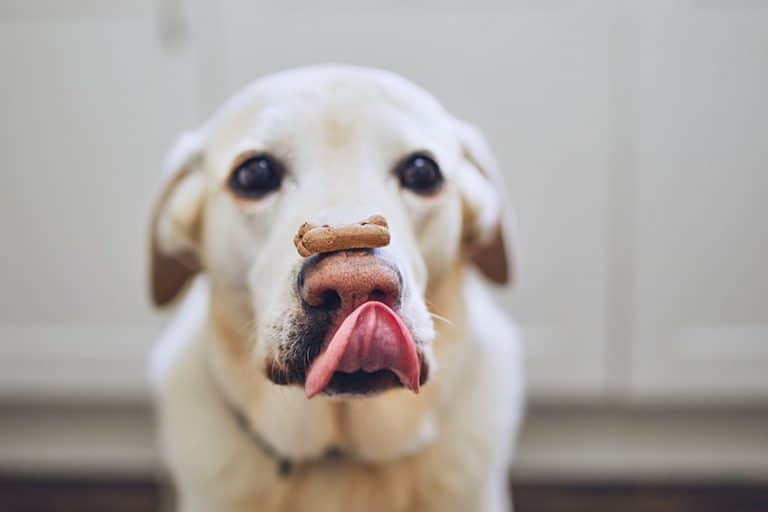
Burying His Bones and Toys
The bottom line is that digging and hiding objects is natural dog behavior. Don’t scold your pup if he buries something. Work with him to find a healthy outlet for his activities.
Dog scratching behavior

My Dog Keeps Scratching
When a pup starts to scratch or to lick himself incessantly, it can become annoying. But remember it’s probably not pleasant for Fido either! If your pal is always itchy, it could be because:
- He has dry skin
- He has a skin allergy
- He has skin parasites like fleas, ticks, or mange
- He has an infection
- Something is hurting him
- He’s bored or anxious about something
With the proper diagnosis and care, you and Fido should both be able to rest easy.
Scratching The Floor
- They may be preparing a comfortable bed
- They’re using the scent glands in their paws to mark territory
- They may be buffing their nails
- They could be doing it to use up some excess energy
- They may be trying to bury or dig up something
- If they’re outside, they may be creating a patch of bare earth to lie down and cool off
Scratching His Bed
- To fluff their bed and make it more comfortable
- To mark their territory
- It’s a carry-over from canine ancestors who would dig dens
- It helps to heat or cool the surface
Dog Biting Habits
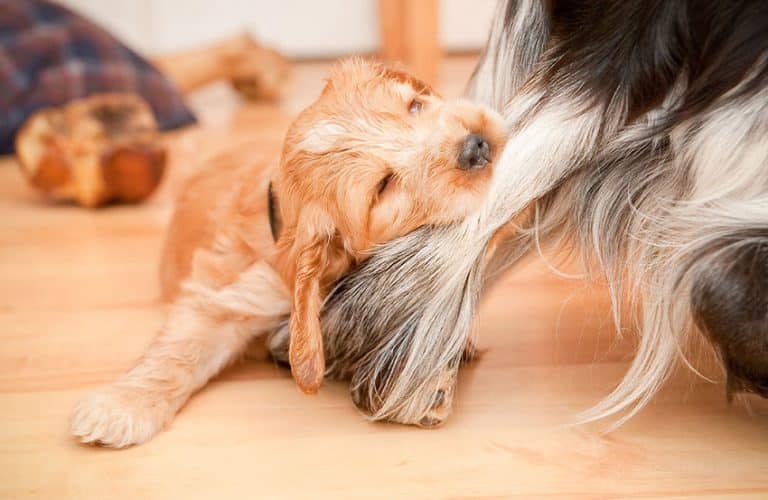
Biting Each Other
- They’re acting out of fear or guarding a resource
- They’re showing dominance over the other pooch
- The other dog won’t leave them alone, and they reach a breaking point
- They’re in pain and lashing out
- It’s a mama dog who’s protecting her puppies
Keeps Biting Me
- Dominance - your pooch thinks he’s boss
- Fear - this is more common in poorly socialized dogs
- Territorial aggression - your pup is guarding you, another family member, or a resource
- Predatory aggression - herding dogs often demonstrate this behavior
- Pain - dogs that are hurting or don’t feel well may snap if you disturb them
- Protection - if you startle a pooch, he may bite as a protective reflex
- Teach your dog proper behavior around others with socialization exercises and exposure to a variety of stressful circumstances.
- Be aware of your pooch’s trigger points for aggression and watch his behavior.
- Use positive reinforcement for good behaviors and avoid using aggressive punishment with your furbaby.
- If your pup has tendencies toward aggression or fear biting warn others in advance.
- Control your dog with a leash or fence until you know how he’ll behave in different settings.
Biting My Feet
Always Bites Me When I Pet him
The bottom line here is that your pal is probably telling you that he needs your attention. Rather than getting upset, take some time to bond with your furbaby by playing with him.
Bites When He Get Excited
- He doesn’t know any better. After all, he mouth-plays with his pup pals
- He likes to have something in his mouth, and you’re right there
- Your hands or feet are in motion, and he likes your response when he nips you
- Having something in his mouth calms him down
The bottom line is that your calm demeanor can set the tone in your home and prevent excitable biting.
Bites Only Me And Not My Husband
- He’s asking for something like dinner and thinks you’ll understand
- Your pal sees you as his personal chew toy or plaything
- You’re doing something that he perceives as a threat
- He doesn’t see you as alpha and is expressing dominance
- There may be something in your scent that sets him off
Bite While Playing
The key point here is that play biting is normal, but you can work with your pooch to teach him to stop. Whenever Fido starts to chomp on you during play, take a break. Stop playing for a set period of time. You can also teach your pal a stop command or offer a chew toy to replace your hand.
Understand Pawing
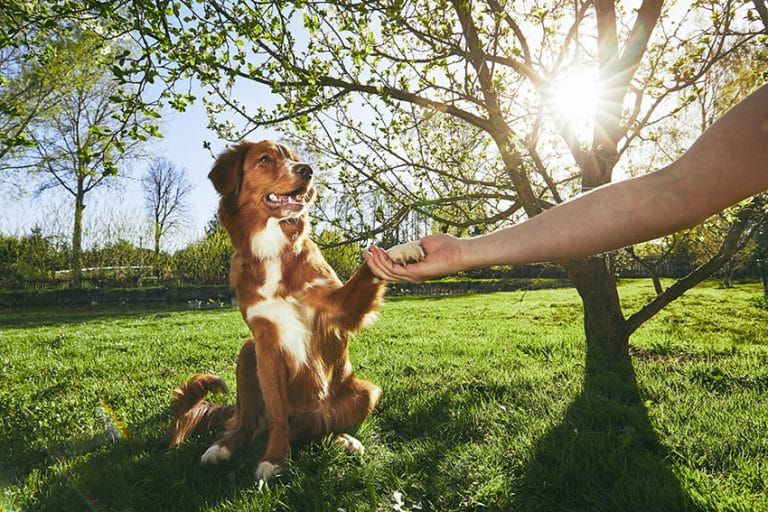
Pawing At Me
- Pay attention to me!
- I’m hungry
- I’m nervous and need your reassurance
- I like/love you
The bottom line is that your canine companion is a social animal, and he craves your attention. However, you can teach him that there is a great reward in waiting patiently for you.
Putting His Paw On My Face
Dog Zoomies
Running Around Like Crazy
- Playing in the snow
- Getting a bath
- You came home
- Too much time indoors
- Lack of playtime
- They’re trying to engage you or another dog in play
- It can be a sign of anxiety or fear about something
The bottom line is that zoomies are a great way for your furry friend to burn off some energy. So, when your pal starts zipping around, give him some space and let him enjoy himself. If you suspect his activity is fear or anxiety based, or if it’s a sudden change in his behavior talk to your veterinarian.
Going Crazy After Bath
It happens with my dogs every time I give them a bath. They go crazy and start zipping around the house. There are some reasons that pups get the zoomies after bath time:
- It’s a sign of relief to be done with the spray down
- They’re trying to dry off
- They’re trying to rub the shampoo scent off
- It’s just plain fun!
Remember that getting a case of the zoomies after a bath is normal and should be expected. There’s nothing wrong with it. If the behavior creates other problems like wet floors and furniture, try confining your pal to a zoom-safe zone or let him go outside (weather permitting). Then sit back and watch the show. Sometimes our furry pals can be adorable and entertaining!
Dog Howling
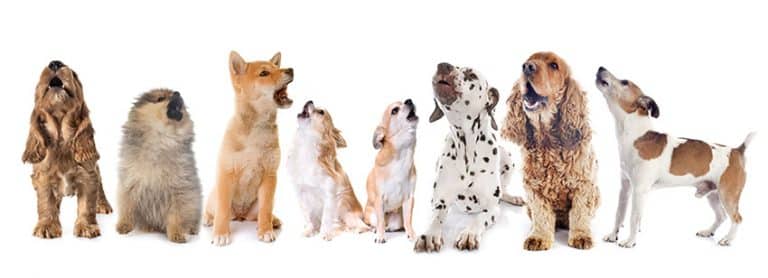
Howling When I sing/Play Music
When your furbaby joins you in a song, he’s just showing you that you’re members of the same pack.
Howling At Sirens
If your furbaby tends to howl when he hears sirens, don’t get upset. He’s just trying to communicate.
Howling at Night
- They’re trying to communicate, and there are fewer competing sounds at night
- For strays or dogs that become separated from their pack, the darkness feels more isolating. This can also be true of pups dealing with separation anxiety.
- Wild canines and strays tend to be more active at night. That’s when your pal will hear them “talking” to one another.
If your pooch goes out and howls at night, maybe he’s talking to other canines in the area. Otherwise, he may be telling you that he needs more time and attention. The key to redirecting the behavior is understanding your pal’s motivation and finding ways to meet his needs.
Howling in His Sleep
If your pal starts howling while he’s asleep, don’t panic. Make sure he’s sleeping and not crying out in pain, but try not to rouse or startle him. Uninterrupted sleep is essential for your furbaby’s health and well-being.
Dog Laying and Sleeping Positions
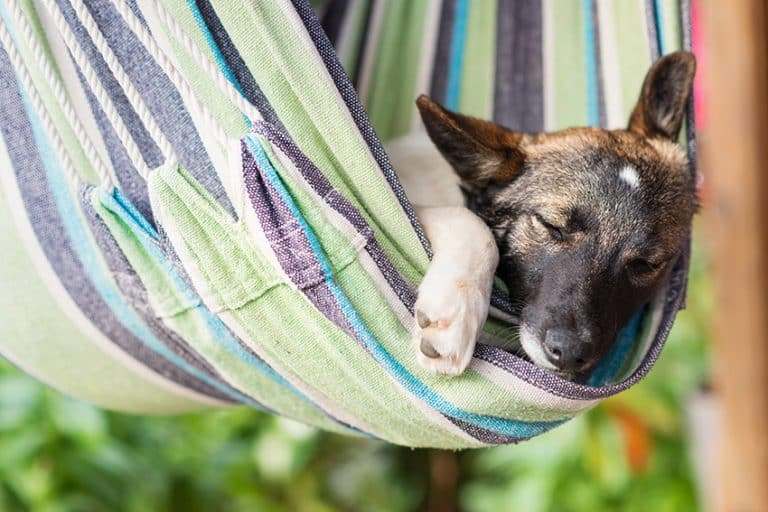
Laying Out in the Sun
- It helps them form and absorb vitamin D
- The sun’s rays boost immunity
- The warmth is soothing for joint pain
- It’s relaxing, and the rays stimulate serotonin production which boosts happiness
- It can help pups sleep better
- It helps bring warmth on a cold day
The bottom line is that as long as you practice moderation, you can let your pooch enjoy his time in the sun. It will do him a world of good.
Likes Laying On Me
The bottom line is that some dogs love to be close. If you show them plenty of TLC they’ll probably understand when you make a little space for yourself.
Sleeping All Day
Unless you see changes in your pal’s behavior, let a sleeping dog lie. He’s just getting his beauty rest.
Sleeping On His Back
- They feel safe with you
- It helps them cool off when they’re hot
- They’re catching some sun rays
- His back is itchy, and he’s scratching it
- He wants a belly rub
- He’s showing submission or appeasement
- He’s playing with another dog, and the rollover is an effective combat posture
When your furbaby rolls over on his back, check him out. By observing his body language and behavior, you should be able to understand why he’s doing it.
Sleeping Between My Legs
- As pack animals, they’re used to huddling together
- It’s a sign of submission to you as their leader
- They’re feeling insecure about something, and they feel protected between your legs
- They want to be close to you
- They can face the door and be ready to protect you from any intruders
- You may have encouraged him to take the position by petting him or scratching his ears when he’s there
When your pooch curls up in bed between your feet or legs, it shows you that he loves and trusts you. If his position is interfering with your ability to sleep, try encouraging him to curl up in his own bed by offering praise and positive reinforcement. Otherwise, let your pal enjoy the security of being close to you.
Sleeping Next To Me
- Some dogs get lonely
- They’re cold
- The freshly laundered sheets smell good
- The bedding has their/your scent on it
- There’s more room to stretch out
- Entitlement
- Your bed is softer or more comfortable than theirs
- They love you and want to be by you
Not only are there benefits for Fido when he sleeps with you, but there are also rewards for you. Dogs can help us relax, keep us warm, and make us feel safer. So, the bottom line is that sleeping next to your pooch can be mutually beneficial.
Curling up when he sleeps
If you have a new puppy or rescue dog, give him time and space to get comfortable. You could also consider giving your pooch a blanket where he can make a cozy nest.
Sleeping On My Pillow
- It’s the most comfortable spot in the house
- He sees you do it and wants to imitate you
- You sleep there, so it has your scent, and that’s a comfort to him
- He’s leaving his mark on top of your scent
- He’s getting close to protect you
- He’s trying to bond with you
- It gets your attention
If you don’t want to share your pillow, try getting your pooch a comfy bed and placing it in a warm, secure place. Otherwise, there’s no harm in letting your special pal snooze on your bed. He’s just trying to stick close to you.
Sleeping On My Clothes
- They’re comfy and warm
- They smell like you, and that’s comforting for your pup
- He’s suffering from separation anxiety, and the duds make him feel more secure
The bottom line is that your canine companion probably sleeps on your clothes because they’re yours and give him a sense of comfort. By providing him with something to call his own, you can help him feel safe and secure.
Twiching/Shaking in his sleep
Barking Or Crying In His Sleep
You wake up in the middle of the night because Fido is whimpering and barking excitedly. When you go to check on him, he’s sleeping. During their dream sequences, dogs will sometimes growl, bark, or make other noises. According to an MIT study, dogs experience dreams that are similar to ours. It’s a small wonder they talk in their sleep like some humans. It probably takes the average pooch about 20 minutes to start dreaming. Evidence suggests the visions in their head are replays of daily activities.
When your pooch starts to vocalize in his sleep, it’s normal. Let him complete the dream, even if you think he’s having a nightmare. That way he’ll be able to complete the sleep cycle and get his needed rest.
Meanings Behind Different Dog Sounds
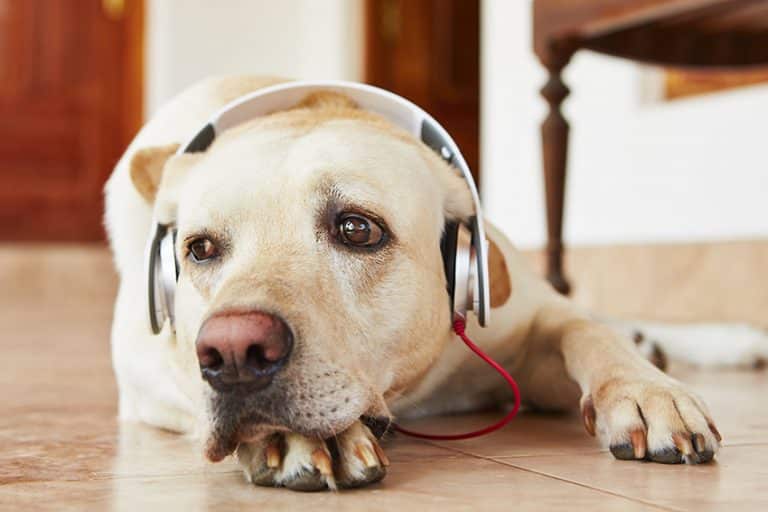
Sighs After Lying Down
The thing you need to know is that your pup’s body language will help you understand the meaning of his sighs so that you can better care for his needs.
Makes Moaning/Groaning Noises
- To tell you that being petted or getting his tummy rubbed feels good
- To say that he’s tired and ready to rest after a good workout
- Because you’re not doing what they want you to do (like sharing your dinner)
- He has a medical condition that’s causing pain or discomfort
- Some groan when they’re in REM sleep
The key here is that if you’re not sure why your pal is moaning, get it checked out. Understanding the reasons behind your pal’s behavior will help you take good care of him.
Whimpering and Whining
- They’re excited about the outing
- They’re nervous or afraid
- They’re uncomfortable - hot or feeling ill
- They need to go potty
- They’re hungry or thirsty
The bottom line is that you can train your pooch to ride quietly in the car, and a peaceful trip is good for both of you.
Hiding And Acting Strange
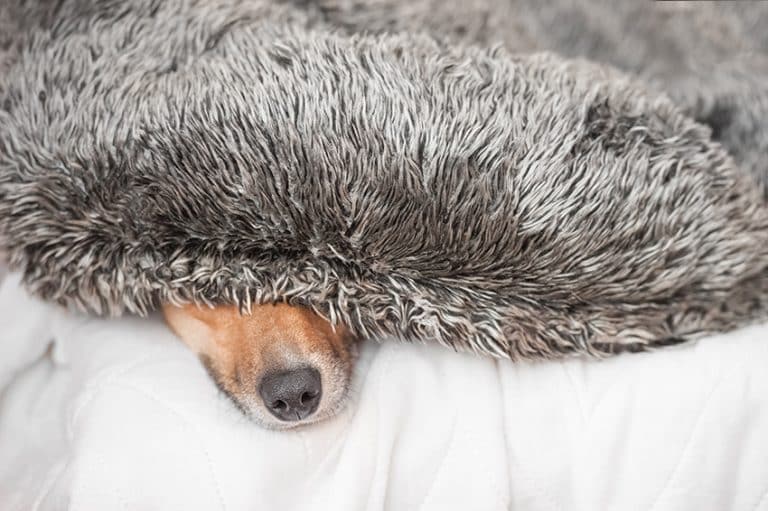
Hiding And Sleeping Under The Bed
- He’s afraid of something
- He’s struggling with anxiety about something
- It’s dark, cool, and comfortable
Sleeping Under The Covers
So, don’t feel annoyed or concerned when your four-footed friend climbs under the covers with you. He’s in his safe place with you. If the behavior is new, you may want to check with your veterinarian.
Dog Chasing Habits
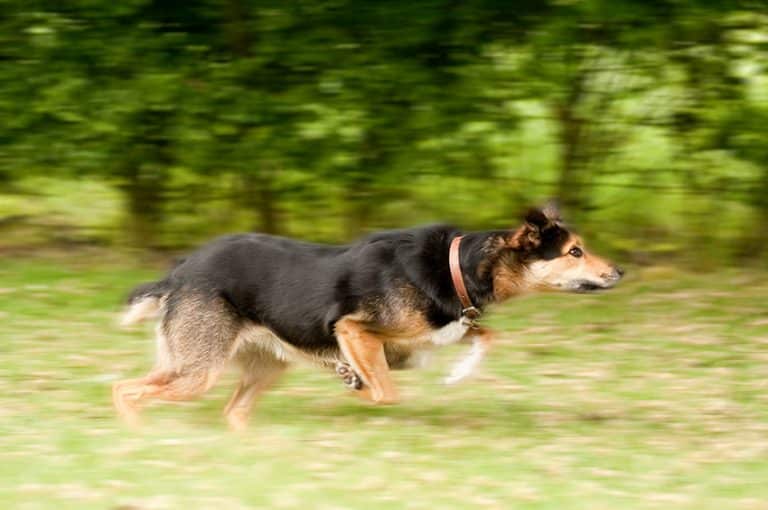
Chasing Cats
The bottom line is that with patience and training, dogs and cats can live together amicably.
Chasing Cars
The key here is to patiently work with your pooch until he learns the greater reward is looking at you when he sees moving traffic.
Chasing Squirrels
Work with your pooch to find something he enjoys more than chasing squirrels, and he may just thank you.
Why is my Dog Pacing Back and Forth?
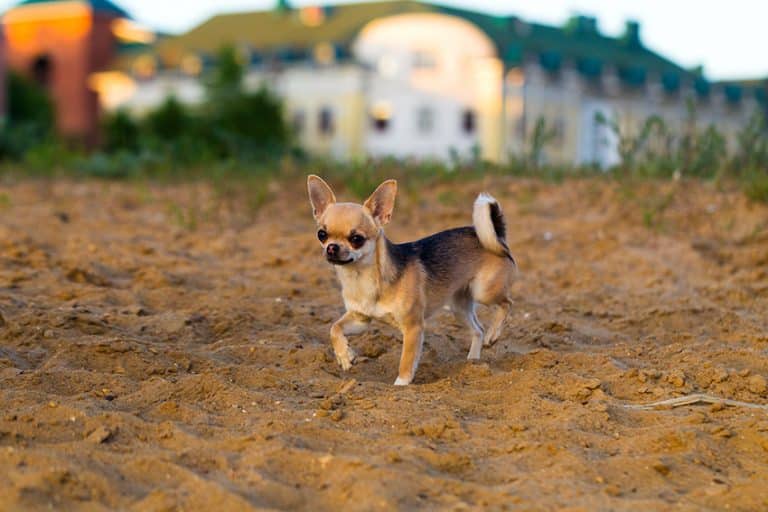
- They’re excited or overstimulated
- They’re bored or have excess energy to burn
- They lost something like a favorite toy and are searching for it
- They can’t get comfortable
- They’re hungry
- A female in heat may pace
- They’re trying to get your attention
- Some medical and neurological conditions trigger pacing
The bottom line here is that you should strive to understand your dog’s normal behaviors and pacing triggers. That way, you’ll be able to help him relax.
Help! My Dog is Drinking Out of the Toilet
- It may be fresher than the water in their drinking dish
- It doesn’t have that plastic taste
- It’s always available unless you put the lid down
- The sound of running water attracts your pup
- The bathroom is quieter and more private
The bottom line is it’s best to keep your pooch from making the toilet his water dish. The best way to prevent this is to deny access by keeping the lid down and shutting the bathroom door. If you have kids that always forget, make sure Fido always has clean, fresh water available elsewhere and keep the toilet clean.
Overly Jealous Dog
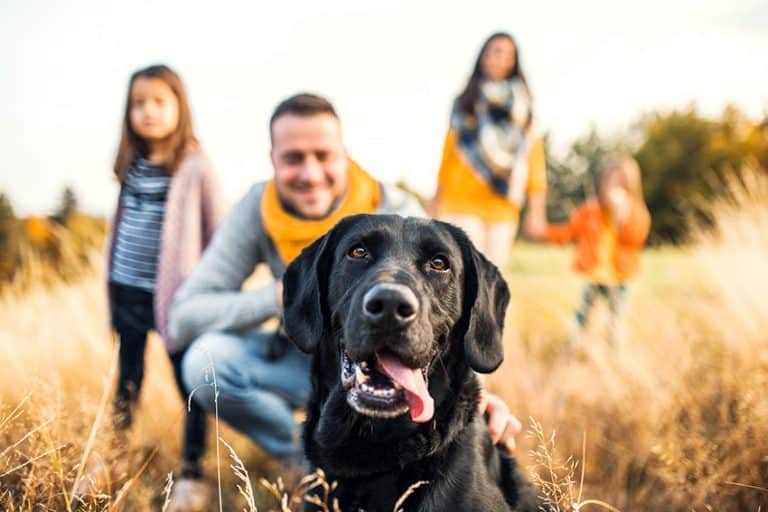
My springer gets upset any time I pay attention to someone else in the house. Is she jealous? According to Christine Harris and fellow researchers at the University of California, Davis, dogs do get jealous. The team studied canine reactions when their owners ignored them and paid attention to other objects, one of which was a stuffed pup that wagged its tail and barked. While the pooches showed a minimal reaction to their owners interacting with a jack-o-lantern or reading a book, they treated the stuffed animal like a rival vying for their human’s affections.
Another study observed dog reactions to their owners attending to another pooch as compared to interacting with an inanimate object. They found a stronger jealous response when Fido perceived a social rival.
Why Is My Dog Walking Sideways (crabbing)?
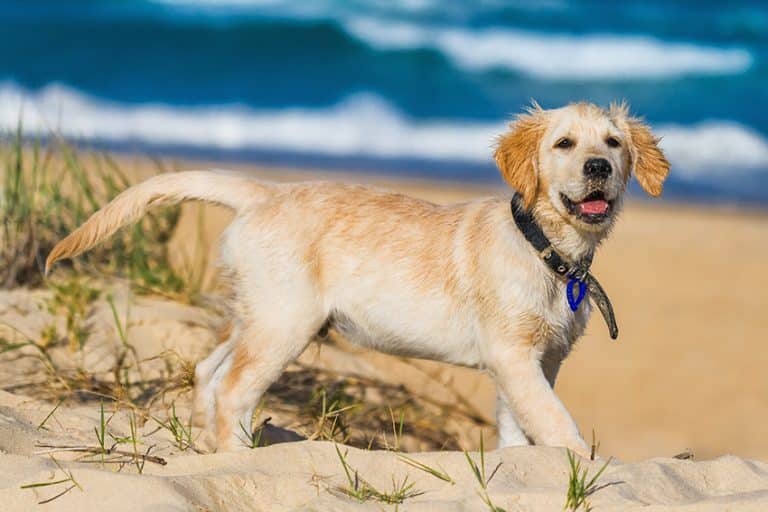
So, if your pooch has always been a crab walker, no worries. He’s just built to move that way.
My Dog Loves Watching TV With Me
My dog keeps bringing me his toys
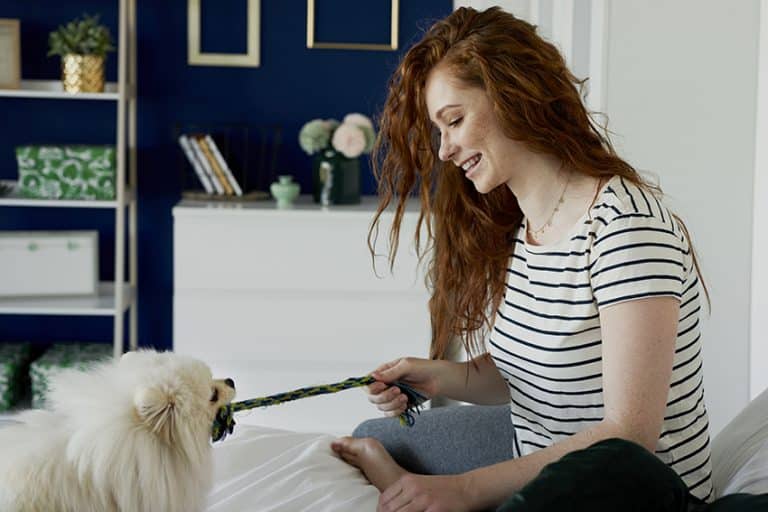
- They’re happy to see you when you get home
- It’s a gift to show you how much they love you
- To announce that it’s playtime
- He’s bringing you an offering because you’re his pack leader
- You trained him by your response to him when he brings you a toy
- He carries it around for comfort or reassurance in your absence
My Dog Keeps Tipping His Food Bowl Over
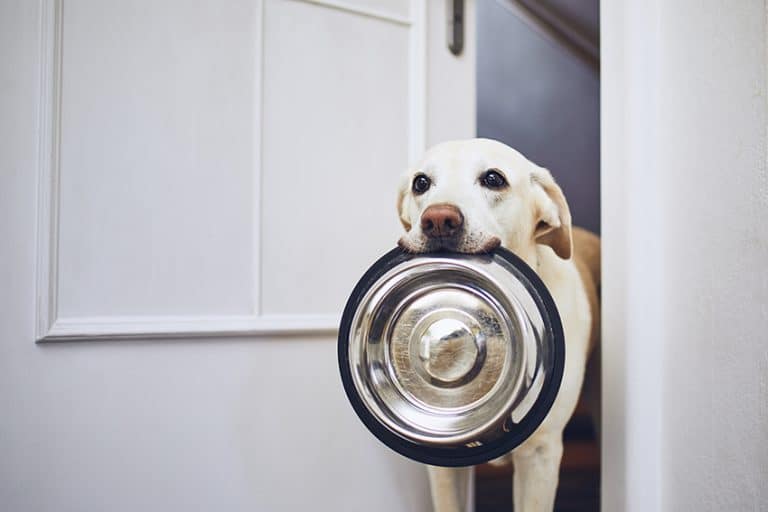
- It’s a throwback instinct to forage for their food
- They’re trying to move the bowl to a private place but overturn it instead
- They don’t like the bowl. It may smell or taste funny to them
- Some dogs nudge or tip the bowl in play or curiosity
- You might encourage the behavior if you refill the dish after he spills it
- On rare occasion, it can be a sign of a medical issue, particularly if your pooch moves the bowl around but doesn’t eat much
The bottom line is that your furbaby probably doesn’t mean to make a mess when he spills his bowl. Don’t scold him for being a dog. Work to find a solution you can both live with.
Begging For Food at the Table
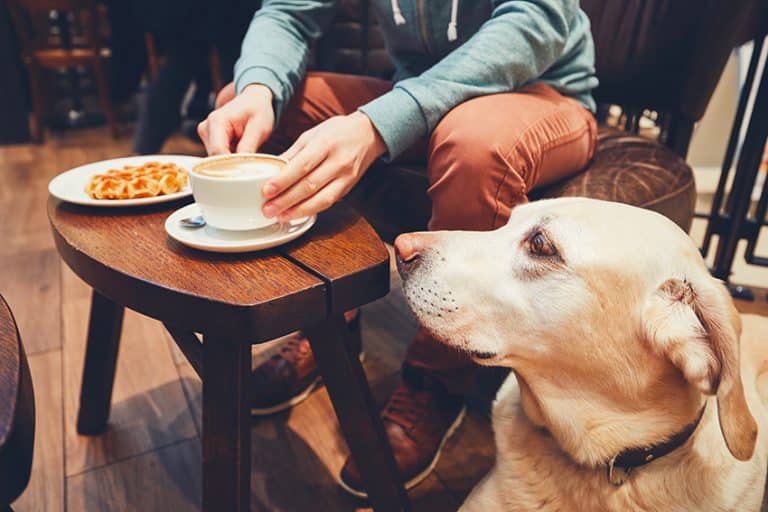
- Don’t give your pup food directly from the table
- Feed your pooch before or during your meal so that he’s not hungry when you’re eating
- Use a crate or a tether and cushion during feeding time. You can also give Fido a bone or a stuffed Kong to work on during this time
- If you want to treat your pup, give the goodies in a separate location or room so that he learns he won’t get any food rewards if he’s by the table
The take-home message here is that you can shape your dog’s begging activity by reinforcing the behavior you want to see.
Protecting his baby sister
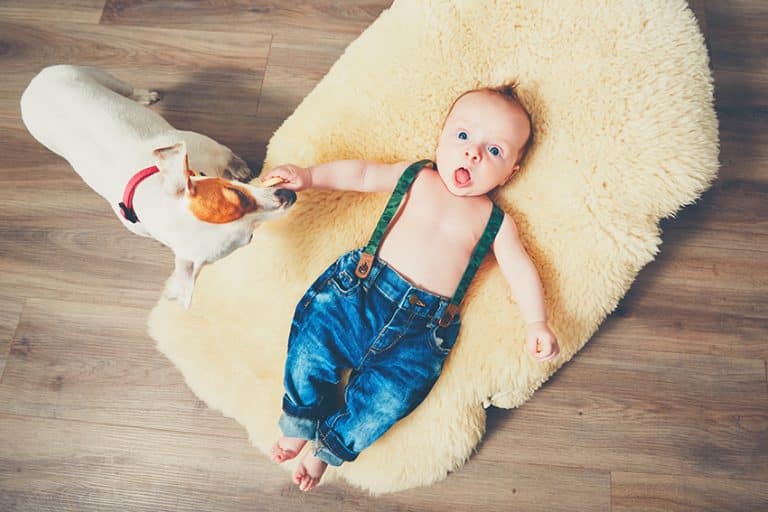
The bottom line is that if you have babies or toddlers in your home, consider a pooch that will make a good guard dog for the whole family.
Giving Me His back
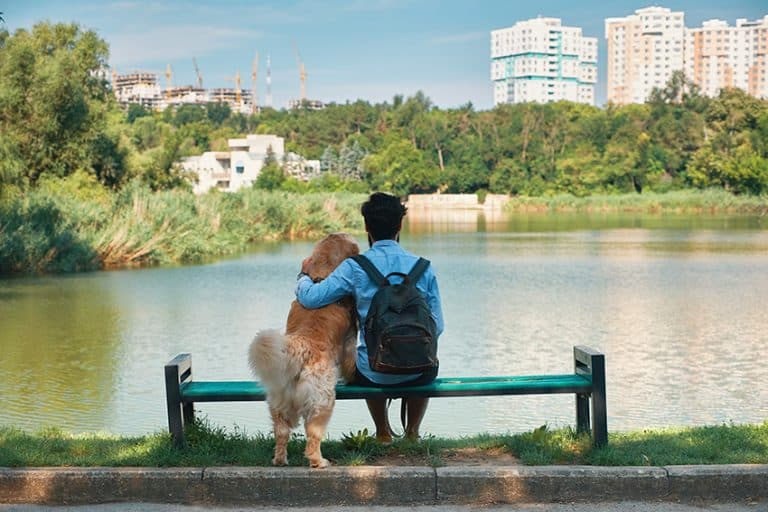
When your special pal presents you with his butt, don’t be worried or offended. He’s showing you that he trusts you, and he may be asking for a little scratch.
Dog Staring Habits
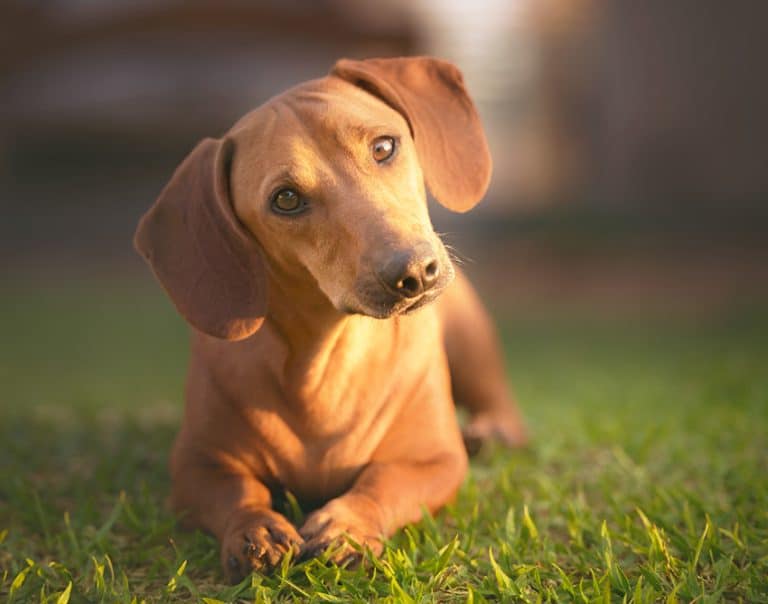
Sitting And Staring At Me
- He’s looking into your eyes to show affection
- He’s watching you to figure out what’s next
- He’s asking you for dinner, attention, or something else
- He’s begging
- A hard, unblinking stare can be a sign of aggression
One word of caution, an unfamiliar dog may interpret a direct stare as a challenge. For that reason, we only encourage locking eyes with a pup when you have an established human-animal bond and no history of aggression or behavior issues.
Staring Into My Eyes
When your furbaby gazes lovingly in your eyes, don’t be concerned. They’re sharing a mutually beneficial moment with you.
Staring At Nothing
- They heard a sound and are practicing active listening to hear better
- You may have trained your pooch that he gets your attention by staring
- They could have canine cognitive dysfunction syndrome (CDS) or dementia
- They could be having a mild type of seizure called an Absence Seizure
- It could be a compulsive disorder
If you see your pal staring, give your vet a call. Based on your observations and Fido’s age and health history, he can recommend the next steps.
Staring At The Wall
The key here is that when your pooch starts staring at the wall, it may be cause for further investigation. Contact your veterinarian to schedule an examination.
Likes Sticking His Head Out the Car Window
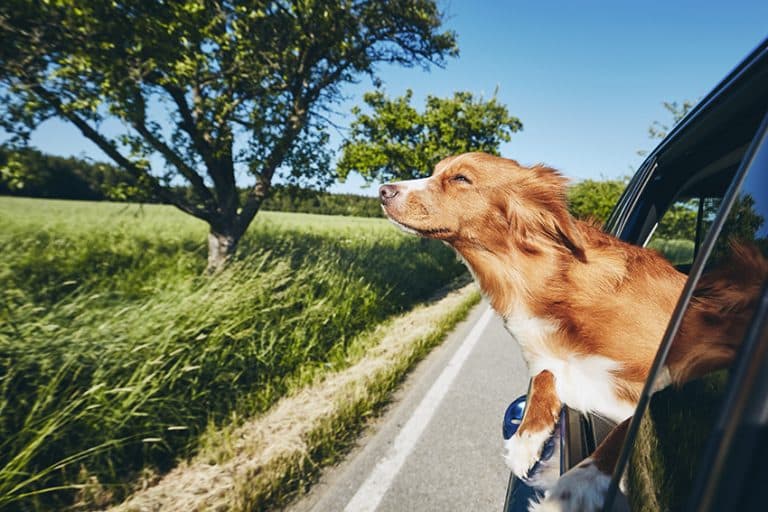
My dog is head butting me
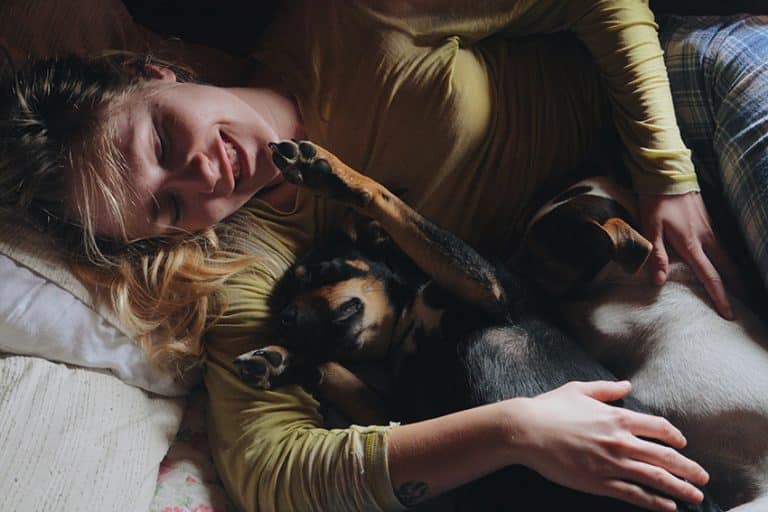
Constantly Poking Me with his Nose

The bottom line is that sometimes nose pokes can go overboard. When our pooch continually prods you with a cold, wet snout it becomes annoying. Thankfully, with patience and time, you can train your pup to cool it. Consistently ignore any begging, nudging, or playful yips and Fido will eventually get the message.
My dog shows aggression to other dogs
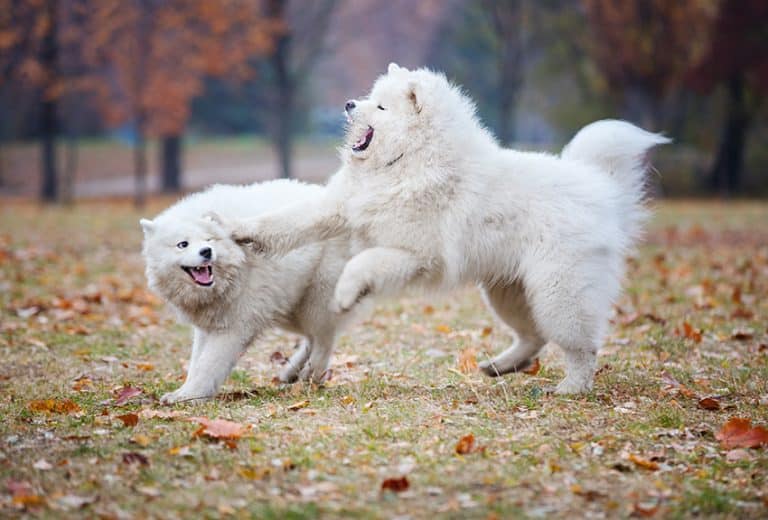
- A strange animal is invading Fido’s territory
- Your pal is trying to protect you, his food, or something else
- Overstimulation can cause a friendly play session to escalate into a fight
- Your dog is frustrated that he can’t get at what’s really ticking him off, and he redirects his aggression at his packmate
- Rage syndrome - added stressors that increase household tension
- Same-sex aggression
- Stressors like changes in the routine or family members
The bottom line is that dogfights are scary and dangerous. Your best bet is to prevent escalating aggression in the first place. Whenever your pooch is interacting with another dog, watch their behavior. Intervene if you notice any signs of tension or dominant behaviors. Better safe than sorry, right?
Jumping On Me
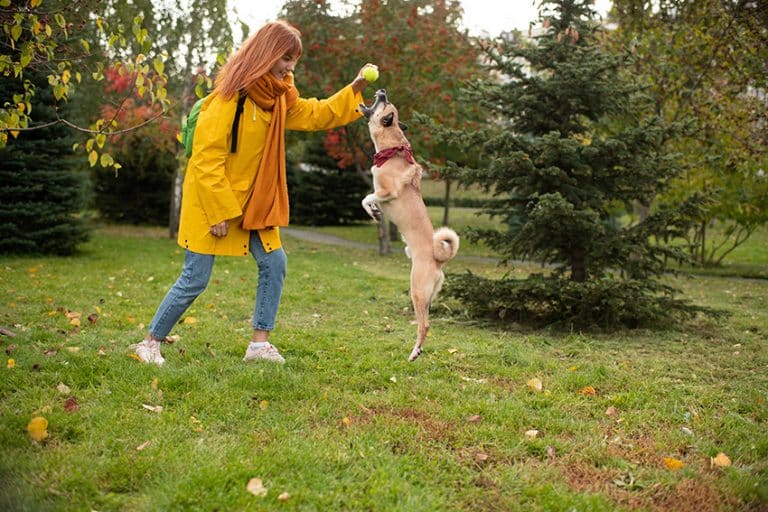
The bottom line is that you can train your pup to sit for petting rather than jumping on you or other people. It just takes persistence.
Standing Over Me
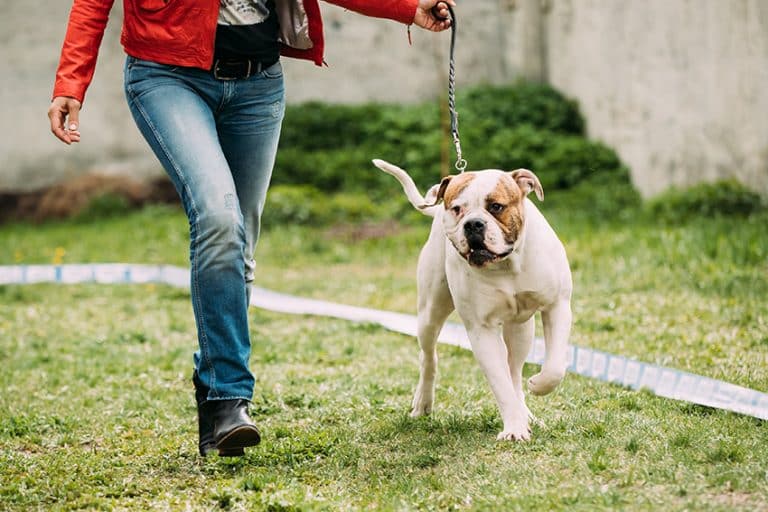
Of course, you should be the leader of the pack. So, if your furbaby is trying to stand over you, you’ll need to remind him who’s boss. Don’t fly off the handle but correct Fido with gentle firmness. Stay consistent, and he’ll get the message. However, if your companion resists your rebukes, consult a trainer. The sooner you can adjust your pal’s behavior, the safer you’ll both be.
Why Do Dogs Play Fighting With Other Dogs?
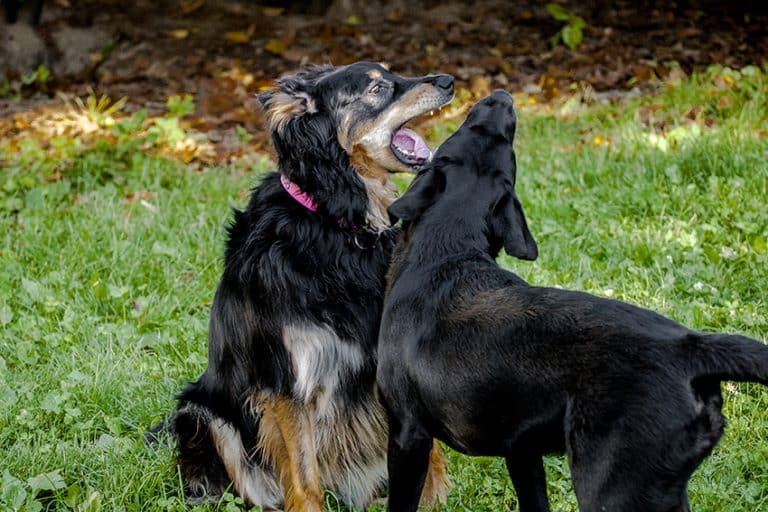
The key here is that play fighting is beneficial to your dog in many ways. Whether you interact with your pooch or set up puppy playdates, you’ll be doing Fido a favor when you encourage amicable play.
Speak Fluent Woof With Your Dog
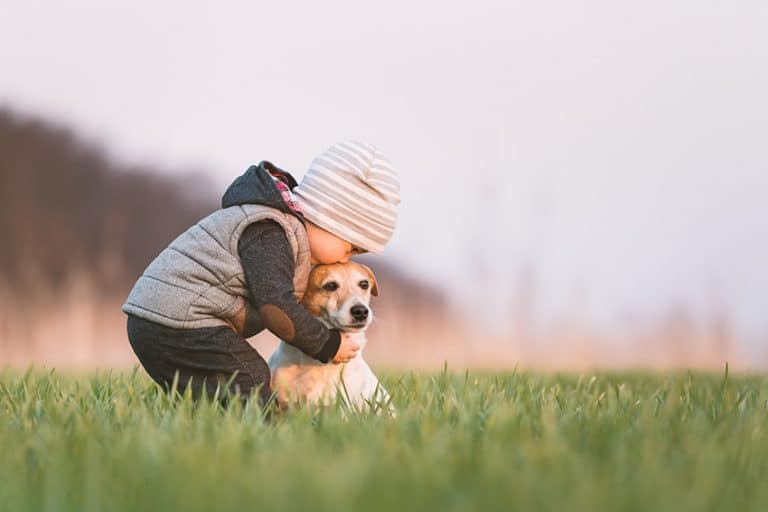
Did we answer your questions about your pup’s behavior? If there’s something you want to know about your dog’s behavior that we didn’t cover, leave a message below. We’ll add it to our list.


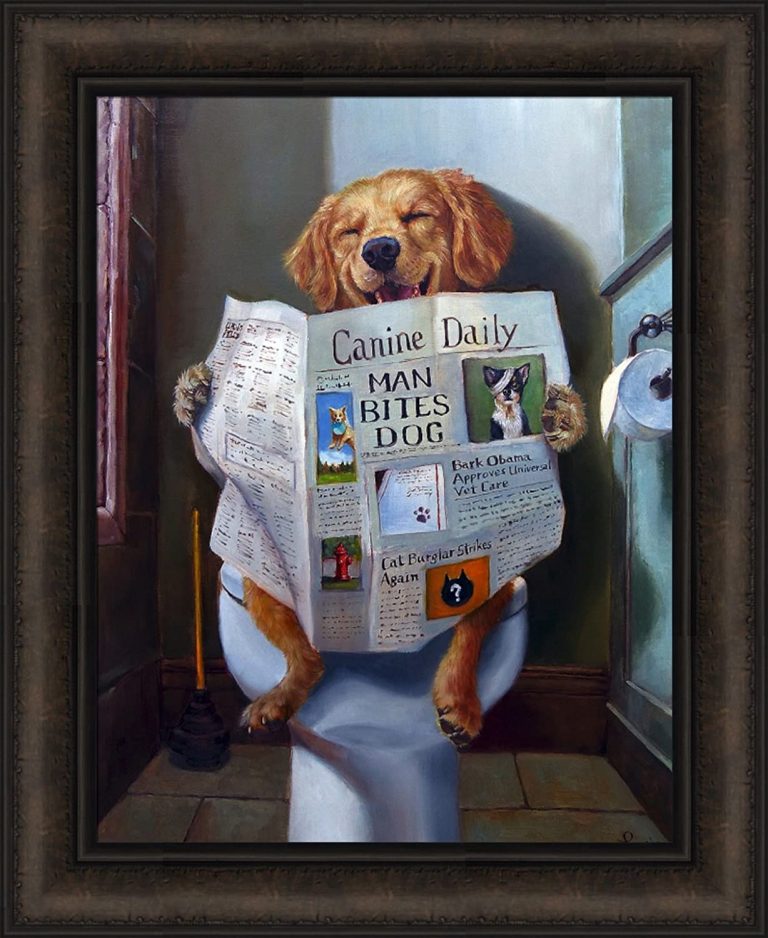

Great article! I have had dogs all my life and often wondered about some of their behavioral traits. This article touched and everything. Thank you so much for sharing your knowledge.